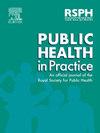Satisfaction of indigenous pregnant women with a mobile voice application in Quechua developed by midwives for prenatal care in Peru
IF 1.9
Q2 PUBLIC, ENVIRONMENTAL & OCCUPATIONAL HEALTH
引用次数: 0
Abstract
Objectives
Despite the effort shown by health personnel, many of them still have limitations in communicating with Peruvian Quechua-speaking pregnant women. The mobile applications have become an alternative to complement health care during pregnancy, especially if, as in Peru, the use of mobile devices has increased significantly, even in indigenous communities. Thus, the objective of this research was to evaluate the satisfaction of indigenous pregnant women from a Peruvian rural community with a mobile voice application in Quechua developed by midwives for prenatal care.
Study design
Cross-sectional study with a questionnaire.
Methods
The research was developed with 120 pregnant women from the rural community of Marian (3320 m a.s.l., Huaraz, Peru), who after a thorough explanation and the voluntary signing of a declaration of informed consent, accepted the free installation of the application. Thus, after at least 6 months of use, they answered a previously validated questionnaire with 23 questions between August 2023 and July 2024. A descriptive analysis was applied.
Results
It was evidenced that 82.5 % of pregnant women were satisfied with the application. Three (21.4 %) of 14 features were rated with dissatisfaction or indifference such as speed of functions, content about maternal-foetal bonding and appearance, with scores of 2.98, 2.92 and 3.46, respectively. The best valued aspect was the information about warning signs during pregnancy, childbirth and postpartum with a score of 4.71, while the information about activities that promote maternal-foetal bonding received the lowest score (2.92).
Conclusions
The majority of indigenous pregnant women from Marian community were satisfied with mobile voice application in Quechua for prenatal care, so with some improvements such as appearance, speed of functions and content about maternal-foetal bonding, it could be used for free in rural areas as a solution proposal to language barriers that limit health care in vulnerable populations.
土著孕妇对秘鲁助产士为产前护理开发的克丘亚语移动语音应用程序的满意度
尽管卫生人员做出了努力,但他们中的许多人在与讲克丘亚语的秘鲁孕妇沟通方面仍然受到限制。移动应用程序已成为怀孕期间补充保健的一种替代办法,特别是在秘鲁,即使在土著社区,移动设备的使用也大大增加的情况下。因此,本研究的目的是评估来自秘鲁农村社区的土著孕妇对助产士开发的用于产前护理的克丘亚语移动语音应用程序的满意度。研究设计采用问卷调查的横断面研究。方法本研究选取了120名来自Marian (3320 m a.s.l, Huaraz, Peru)农村社区的孕妇为研究对象,经详细说明并自愿签署知情同意声明后,接受免费安装应用程序。因此,在使用至少6个月后,他们在2023年8月至2024年7月期间回答了一份包含23个问题的预先验证问卷。采用描述性分析。结果82.5%的孕妇对应用满意。在14个特征中,有3个(21.4%)被评为不满意或不满意,分别为功能速度、母婴关系内容和外观,得分分别为2.98、2.92和3.46。最受重视的方面是怀孕、分娩和产后的警告信号信息,得分为4.71,而促进母婴关系的活动信息得分最低,得分为2.92。结论玛丽安社区大多数土著孕妇对克丘亚语移动语音产前保健服务感到满意,在外观、功能速度和母婴结合内容等方面进行改进,可在农村地区免费使用,解决弱势群体的语言障碍问题。
本文章由计算机程序翻译,如有差异,请以英文原文为准。
求助全文
约1分钟内获得全文
求助全文

 求助内容:
求助内容: 应助结果提醒方式:
应助结果提醒方式:


